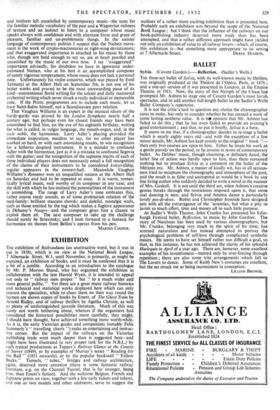BALLET
Sylvia. (Covent Garden.)—Reflection. (Sadler's Wells.) THE three-act ballet of Sylvia, with its well-known music by Delibes, was originally produced at the Theatre de l'Opera, Paris, in 1876 ; and a one-act version of it was presented in London, at the Empire Theatre, in 1911. Now, the story of this Nymph of the Chase has prompted Mr. Ashton to stage one of Covent Garden's most lavish spectacles, and to add another full-length ballet to the Sadler's Wells Ballet Company's repertoire.
It is not the critic's task to question any choice the choreographer cares to make, but only to consider whether he has created a work of some lasting aesthetic value. It is rnt opinion that Mr. Ashton has failed to do this ; that he has even failed to provide an evening's good entertainment ; and that, to put it briefly, Sylvia is a bore.
It seems to me that, if a choreographer decides to re-stage a ballet which is nearly eighty years old—and with the exception of a few minor details, Mr. Ashton has kept strictly to the original " book "- then only two courses are open to him. Either he treats his work as a gentle parody on the period, or he invents in terms of contemporary ballet. As Delibes' music, though charming, is definitely dated, the latter line of action was hardly open to him, thus there remained nothing but to produce Sylvia as a comment on the ballet of the Merante era. Mr. Ashton, a master of kindly wit, has in all serious- ness tried to recapture the choreography and atmosphere of the past, and the result is as false and uninspired as would be a book by any fine living author who suddenly decided to write a novel in the manner of Mrs. Gaskell. It is not until the third act, when Ashton's creative genius breaks through the restrictions imposed upon it, that some real dancing is seen, and Sylvia and Aminta dance a particularly lovely pas:de-deux. Robin and Christopher Ironside have designed sets with all the extravagance of the 'seventies, but what a pity to lavish so much effort, time and money all to such little purpose.
At Sadler's Wells Theatre, John Cranko has presented his Edin- burgh Festival ballet, Reflection, to music by John Gardner. The story of Narcissus has been used by various choreographers, but Mr. Cranko, belonging very much to the spirit of his time, has scorned naturalism and has instead attempted to portray the psychological problems of self-love through complicated symbolic means. He seems to have set himself rather too difficult a goal, so that, in this instance, he has not achieved the clarity of his splendid Harlequin in April of a year ago. There are, however, some excellent , examples of his inventiveness—marred only by over-forcing through repetition ; there are also some trite arrangements which fall to The Lovers to dance. Some of Keith New's costumes are excellent, but the set struck me as being inconsistent in conception.
LILLIAN BROWSE.


































 Previous page
Previous page